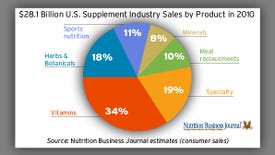A great idea becomes a great business only if you have the tools & knowledge to stay afloat. Only when you can build a plan, execute on that plan and track the details that matter most will your natural products business succeed. These strategies from branded products expert Liz Myslik should be at the core of your consumer packaged goods business.

Entrepreneurs spend considerable time and effort raising money to fund the growth of their brands. Far too often, they spend those dollars in ways that harm, rather than help, their business. Considering that 97 percent of new businesses fail, the stakes are high to get it right.
At Fresca Foods, we’ve worked with so many successful natural food brands over the years that we’ve had the opportunity to see what sets them apart from those who don’t make it. We’ve compiled those observations into a list of 6 fundamental things successful entrepreneurs know and do.
1. Have a (detailed) plan. First, define why you are doing what you are doing and why it matters. This is what truly sets your brand apart and keeps consumers coming back for more. No, it’s not the features or benefits of your product. Simon Sinek offers great perspective on this topic in his book “Start With The Why” (for the time starved, check out his TED talk).

Need data to build your business plan? Check out these charts from Nutrition Business Journal.
Next, answer the basic questions: Who? What? When? Where? How? Define your target market. You can’t be everything to everyone—at least not until you have the marketing budget of Coke—so focus on those who are most likely to buy your product and make it part of their lives every day. Once you define your “who,” the “where” and “how” should be easier. For the “where,” determine the geographic markets, sales channels (natural channel, grocery) and specific retailers (Whole Foods, Safeway) where your consumers are most likely to buy your product. For the “how,” determine your go-to-market approach. This includes deciding how you will connect with your retailers and consumers to entice them to try and buy your products again and again. What are the marketing programs, promotions and people you will need, and what do they cost? Talk with brokers, retailers, fellow entrepreneurs, trade resources such as NewHope360, and industry advisers to learn what works and what things cost.
2. Use your plan. It’s surprising how many entrepreneurs create a plan to raise money, and then never refer to it again. This is a huge mistake. Use your plan to help you make decisions and stay focused. The hardest thing to do is not to say yes—it’s to say no. You will have infinite possibilities and options to grow your brand, but staying focused and true to your path will help you succeed.
One way to stay focused is to create quarterly milestones that are both financial (revenue, contribution margin, current ratio, cash on hand) and strategic (velocity, number of stores, social media buzz). Evaluate your achievements against these metrics each quarter. You will quickly see what’s working and what’s not. Force yourself to take action based on your results, even if it means making difficult decisions about your product, your team, or your plan.
3. Start small, think big. Whether it is price point, packaging, positioning or formulation—all new products require some kind of change that was not anticipated before launch. This is true no matter how big or small the brand. If you want to build a brand that has mass appeal, start in your own back yard. Sell and market your products where you can be physically present. Close proximity to your retailers and consumers is a huge source of competitive advantage, because it allows you to gain valuable feedback (good and bad) that you can act on. The more you know about what’s happening at the store level and what consumers are thinking and feeling, the more info you will have to drive decisions and grow your brand.
It is essential that you get your brand’s formula right before even thinking about expanding to additional markets and retailers. Changes are far easier and less expensive to make on a smaller scale. If you really focus on this, you will spend less time and money on your way to success.
4. Grow smart. Getting products on the shelf is easy. Retailers like Whole Foods Market are increasingly looking for exciting new products as a way to differentiate themselves from their competitors. Getting products offthe shelf, on the other hand, is hard. Attracting consumers to your brand and getting them to buy again and again will be the difference between success and failure. Most entrepreneurs spend far too much time thinking about getting distribution (new stores) and not enough time growing velocity (the rate that your products move through each store). For that reason, we often say sales can be your greatest distraction. Selling into new retailers is sexy, because you see immediate growth in revenue. However, remember that each new store requires substantial time and money to ensure your products move. You won’t have much time to demonstrate that your products will sell. Retail buyers are under tremendous pressure to maximize profit per square inch. If your products aren’t selling, they will be gone.
Instead of focusing on growing the number of stores you have, focus on growing velocity in a smaller set of stores. You will learn what works and create a success story that will help you win not only with your current retailers, but also all those who follow.
5. Cash flow is king. Manage your cash flow—not your P&L. You will create and use a pro forma P&L/income statement in your business plan and with investors. Remember that your income statement is very different from your cash flow statement. You can be profitable but have no cash. This discrepancy occurs because of many things. One is that manufacturing costs typically happen in lumpy patterns and generally don’t follow a demand curve, like your income statement. Another is that the span of time between purchasing ingredients and getting paid by distributors or retailers can take many months. So you may show that you booked sales on your income statement, but run out of money before the checks come in. This problem is very common.
It’s also important to consider investment and financing activities of your business. Are you purchasing capital assets, such as equipment? Are you paying off credit card debt or loans to help finance your business? None of these will be on your P&L, but they certainly affect your cash balance.
Lack of cash is why most businesses fail. Many smart investors have put money into companies with great products and strong projections, but they simply ran out of cash. How do you avoid this from happening to your investors or to you? Monitor your cash flow each month, know what is coming in and going out, and use this knowledge to plan expenses. Then do what our friend Andy Whitman of 2x Consumer Products Growth Partners recommends: Plan for cash outflows to be twice as high as you expect and for cash inflows to take twice as long as you expect.
6. Margin matters … a lot. Last, but certainly not least, to build a successful brand, focus on your gross margin. A healthy gross margin is the most sustainable and the cheapest way to build your company. That’s because other sources of growth capital come with additional costs, like giving up equity or paying interest. In addition, strong gross margins not only fund your growth, but also increase the value of your business if you ever want to sell it.
The first step to increasing your margin is to know what it costs to produce your product—every single element of it. Next, understand the drivers of these costs. For example, what are the volume thresholds for each of your raw materials that allow you to get better prices? Are there opportunities to buy in greater volumes now? What distribution strategies will help you save on freight costs? What should you set your minimum order quantity at to avoid costly freight charges? How can you modify your process to be more efficient and use less labor? Even if you use a co-packer, producing your products more efficiently is more critical to your success than to the co-packer, so work with them to drive down waste and labor costs when making your product.
Following these six tips will not guarantee your success, but it will give you a fighting chance. Follow your heart, enjoy small wins along the way, and have fun! For more ideas like these, visit the Fresca Foods Inspiration Page.
Liz Myslik is CEO of Fresca Brands and Executive Vice President/Partner at parent company Fresca Foods, Inc. She has been a brand marketer for over 20 years, and for more than half of that time has been building brands in the natural products industry. She has served as a marketing executive, adviser, investor, CEO and board member to high growth natural brands. Liz’s expertise is growing early stage companies to national scale by focusing on a “bottom up” approach to marketing; connecting with consumers in an authentic way and building strong loyalty.
About the Author(s)
You May Also Like




